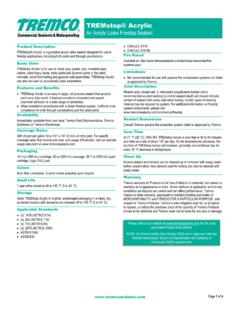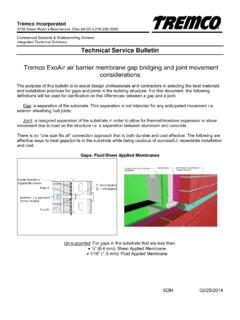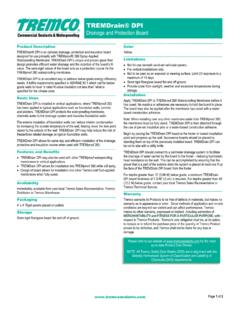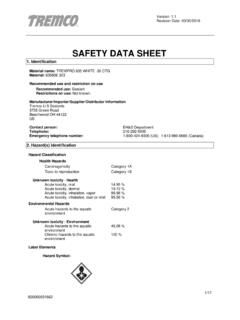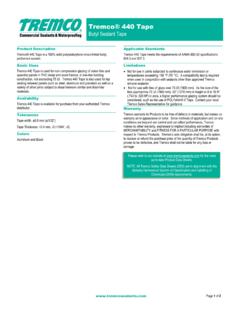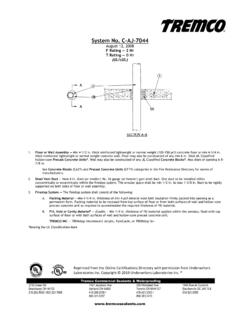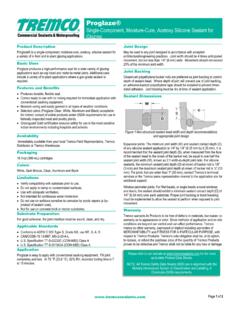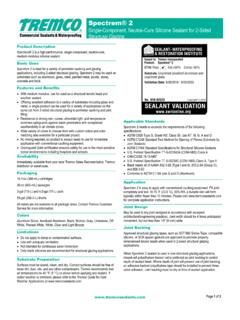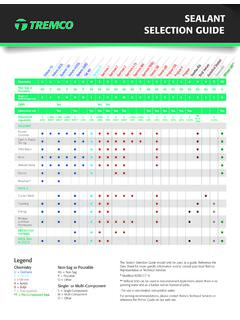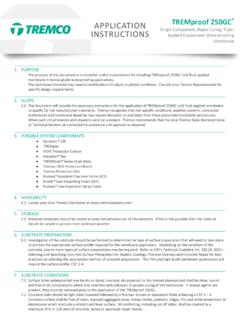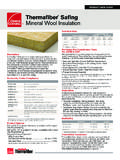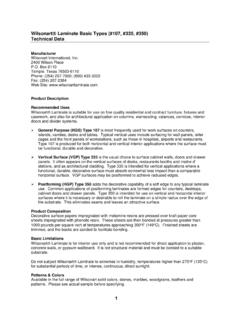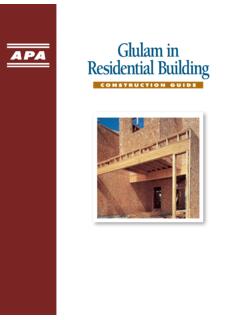Transcription of High-Performance, High-Movement, Single-Component ...
1 Dymonic 100 high - performance , high - movement , Single-Component , polyurethane sealant Page 1 of 3 Product Description Dymonic 100 is a high - performance , high - movement , Single-Component , medium-modulus, low-VOC, UV-stable, non-sag polyurethane sealant . Basic Uses Dymonic 100 is a durable, flexible sealant that offers excellent performance in moving joints and exhibits tenacious adhesion once fully cured. Typical applications for Dymonic 100 include expansion and control joints, precast concrete panel joints, perimeter caulking (windows, doors, and panels), aluminum, masonry and vinyl siding. Dymonic 100 is also an excellent choice as a fluid applied flashing material in rough opening perimeters for fenestration/window, door and curtain wall applications. Features and Benefits Can adhere to damp or green concrete and has a skin time of 2 hr with a tack-f ree time of 6 to 8 hr to significantly reduce dirt attraction.
2 movement capability of +100/-50% in typical field conditions, is low VOC, paintable, jet fuel-resistant, and will not crack, craze or yellow under extreme UV exposure. Suitable for water immersion and will not out gas. Formulated with an innovative polymer technology, similar to TREM proof 250GC and Vulkem 45 SSL, Dymonic 100 is highly versatile and has a unique capability to adhere to damp or green concrete and will not out gas. Compatible and can be coated over with Tremco's Vulkem Deck Coatings, ExoAir Air Barrier products and the cold, fluid-applied TREM proof line of below-grade waterproofing products. Accepted/Compatible for use over Nudura Insulated Concrete Forms (ICF) Availability Dymonic 100 is immediately available from your local Tremco Sales Representative, distributor, or warehouse. Coverage Rates 308' of joint per gallon for a 1/4" x 1/4" (6 mm x 6 mm) joint.
3 For specific coverage rates that include joint size, and usage efficiencies, visit our website usage calculator at Packaging (300-mL) cartridges 20-oz (600-mL) sausages Colors Almond, Aluminum Stone, Anodized Aluminum, Beige, Black, Bronze, Buff, Dark Bronze, Gray, Gray Stone, Hartford Green, Ivory, Light Bronze, Limestone, Natural Clay, Off White, Precast White, Redwood Tan, Sandalwood, Stone, and White. Shelf Life 1 year when stored at 40 to 110 F (5 to 43 C) Storage Store Dymonic 100 in original, undamaged packaging in a clean, dry, protected location with temperatures between 40 to 110 F (5 to 43 C). Applicable Standards Dymonic 100 meets or exceeds the requirements of the following specifications: ASTM C920 Type S, Grade NS, Class 50, Use NT, T, M, A, O, I Federal Specification TT-S-00230C, Class A, Type II CAN/CGSB-19,13-M87 International Code Council (ICC) Section Flashing AAMA 714-15 Specification for Liquid-Applied Flashing NFPA 285 Listed component Fire Rated Systems FF-D-1186, FW-D -1117, HW-D -1122, WW-D -1200, and BW-S-0006 Limitations Use with adequate ventilation.
4 Always utilize the accompanying MSDS for information on Personal Protective Equipment (PPE) and Health Hazards. Not recommended for use in chlorinated, potable, heavy or waste water. Although Dymonic 100 is paintable, this does not imply adhesion to and compatibility with all paints. Consult Tremco Technical Bulletin No. S-09-05 for more information. Substrate Preparation Surfaces must be sound and clean. All release agents, existing waterproofing, dust, loose mortar, paints, other finishes or field applied coating must be removed. This can be accomplished with a thorough wire brushing, grinding, sandblasting, or solvent washing, depending on the contamination. Dymonic 100 high - performance , high movement , Single-Component , polyurethane sealant Page 2 of 3 Tremco recommends that surface temperatures be 40 F (5 C) or above at the time the sealant is applied.
5 If sealant must be applied in temperatures below 40 F, please refer to the Tremco Technical Bulletin for Applying Sealants in Cold Conditions (No. S-0 8-44 rev 1) that can be found on our website at Priming Dymonic 100 typically adheres to common construction substrates without primers; anodized aluminum may require the use of primer. However, Tremco always recommends that a mock-up or field adhesion test be performed on the actual materials being used on the job to verify the need for a primer, proper cleaning and prep requirements. A description of the field adhesion test can be found in appendix X1 of ASTM C1193, Standard Guide for Use of Joint Sealants. Where deemed necessary, use Vulkem Primer #191 Low-VOC on porous substrates and TREM prime Non-Porous Primer for metals or plastics. Application Dymonic 100 is easy to apply with conventional caulking equipment.
6 Ensure that the backer rod is fitted properly for friction and that any necessary primers have been applied. Fill the joint completely with a proper width-to-depth ratio, and then tool to ensure intimate contact of sealant with joint substrates. Dry tooling is always preferred, although compatible wetting agents can be used in limited amounts to slick the spatula if needed after an initial pass. For a cleaner finish, mask the sides of the joint with tape prior to filling. Joint Design Dymonic 100 may be used in vertical or horizontal joints designed in accordance with accepted architectural/engineering practices. Joint width should be 4 times anticipated movement but not less than 1/4" (6 mm). Joint Backing Polyethylene backer rod is recommended as joint backing to control sealant depth and ensure intimate contact of sealant with joint substrate when tooling.
7 Where depth of joint will prevent the use of backer rod, an adhesive backed polyethylene tape (bond breaker tape) should be used to prevent three-sided adhesion. All backing should be dry at the time of sealant application. sealant Dimensions W = sealant width, D = sealant depth, C = Contact area. Expansion Joints- The minimum width and depth of any sealant application should be 1/4" x 1/4" (6 mm x 6 mm). The depth (D) of sealant may be equal to width (W) of joints less than 1/2" wide. For joints from 1/2" to 1" (13 mm to 25 mm) wide, the sealant depth should be approximately one-half of the joint width. The maximum depth (D) of any sealant application should be 1/2" (13 mm). For Joints that are wider than 1" (25 mm) contact Tremco Technical Services or your local Tremco Sales Representative. Window Perimeter- For fillet beads, or angle beads around windows and doors, the sealant should exhibit a minimum surface contact area [C] of 1/4" (6 mm) onto each substrate, with provisions for release at the heel of the angle using backer rod or bond breaker tape.
8 Cure Time Dymonic 100 generally cures at a rate of 3/32" per day at 75 F (24 C) and 50% RH. It will skin in 2 hr and be tack free in 6 to 8 hr. The cure time will increase as temperatures and/or humidity decrease. A typical rule of thumb is one additional day for every 10 F decrease in temperature. Clean Up Excess sealant and smears adjacent to the joint interface can be carefully removed with xylene or mineral spirits before the sealant cures. Any utensils used for tooling can also be cleaned with xylene or mineral spirits. Warranty Tremco warrants its Products to be free of defects in materials but makes no warranty as to appearance or color. Since methods of application and on-site conditions are beyond our control and can affect performance , Tremco makes no other warranty, expressed or implied including warranties of MERCHANTABILITY and FITNESS FOR A PARTICULAR PURPOSE with respect to Tremco Products.
9 Tremco s sole obligation shall be, at its option, to replace or refund the purchase price of the quantity of Tremco Products proven to be defective, and Tremco shall not be liable for any loss or damage. Please refer to our website at for the most up-to-date Product Data Sheets. NOTE: All Tremco Safety Data Sheets (SDS) are in alignment with the Globally Harmonized System of Classification and Labelling of Chemicals (GHS) requirements. Dymonic 100 high - performance , high movement , Single-Component , polyurethane sealant 0321/D100DS-ST Please refer to our website at for the most up-to-date Product Data Sheets. Tremco Commercial Sealants & Waterproofing 3735 Green Rd Beachwood OH 44122 / 1451 Jacobson Ave Ashland OH 44805 / 220 Wicksteed Ave Toronto ON M4H1G7 / 1445 Rue de Coulomb Boucherville QC J4B 7L8 Page 3 of 3 *For temperatures below 40 F, please refer to the Technical Bulletin, Cold Temperature sealant Application Recommendations.
10 TYPICAL PHYSICAL PROPERTIES PROPERTY TEST METHOD TYPICAL VALUES Type single component polyurethane sealant Color 21 Standard Colors Solids 98% Specific Gravity Application gun-grade sealant , applied with typical caulking equipment Rheological Properties ASTM C639 non-sag (NS), 0 of sag in channel Hardness Properties ASTM C661 40 +/-5 Weight Loss ASTM C1246 Pass Skin Time ASTM C679 2 to 3 hr Tack Free Time F (23 C) 50% RH 6 to 8 hr Stain and Color Change ASTM C510 Pass Adhesion to Concrete ASTM C794 35 pli Adhesion to Concrete After Immersion ASTM C794 30 pli Adhesion to Green Concrete ASTM C794 >25 pli Adhesion to Damp Concrete ASTM C794 >20 pli Effects of Accelerated Aging ASTM C793 Pass movement Capability ASTM C719 +/-50% movement Capability ASTM C719* Modified +100/-50% Tensile Strength ASTM D412 350 to 450 psi % Elongation ASTM D412 800 to 900% Modulus at 100% ASTM D412 75 to 85 psi Tear Strength ASTM D412 65 to 75 psi Service Temperature -40 to 180 F (-40 to 82 C) Application Temperature 40 to 100 F (4 to 37 C) * Smoke Development ASTM E84 5 Fire Spread ASTM E84 5 Fire Resistance of Assembly NFPA 285 PASS Smoke Development CAN S102 10 Fire Spread CAN S102 10 Crack Bridging ASTM C1305 PASS Nail Sealability ASTM D1970 Section PASS
